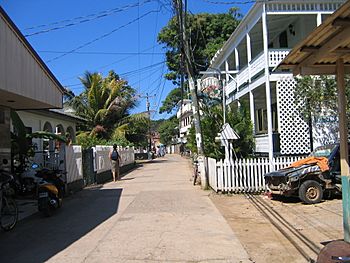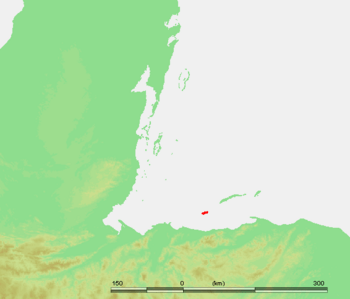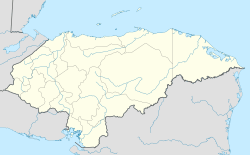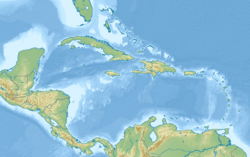Utila facts for kids

Typical road near the Munchies Restaurant, a historic building
|
|||||||||
 |
|||||||||
| Geography | |||||||||
|---|---|---|---|---|---|---|---|---|---|
| Location | Caribbean Sea | ||||||||
| Coordinates | 16°06′N 86°56′W / 16.100°N 86.933°W | ||||||||
| Archipelago | Bay Islands | ||||||||
| Area | 45 km2 (17 sq mi) | ||||||||
| Highest elevation | 74 m (243 ft) | ||||||||
| Administration | |||||||||
| Department | Islas de la Bahía | ||||||||
| Demographics | |||||||||
| Population | 4160 (2015) | ||||||||
|
|||||||||
| Official name: Sistema de Humedales de la Isla de Utila | |||||||||
| Designated: | 2 February 2013 | ||||||||
| Reference #: | 2134 | ||||||||
Utila (also called Isla de Utila in Spanish) is the smallest of the main Bay Islands in Honduras. It is located near the southern end of the Mesoamerican Barrier Reef System, which is the second-largest coral reef in the world! People have known about Utila since Christopher Columbus explored the area. Today, many tourists visit Utila, especially for diving. It is famous for being one of the best places in the world to dive.
Contents
Exploring Utila's Geography
Utila is a beautiful island with interesting natural features. The eastern part of the island has rocks that came from volcanoes. These rocks were formed from several small volcanic cones. One of these, Pumpkin Hill, is the highest point on the island, standing about 74 meters (243 feet) tall.
Who Lives on Utila?
The people of Utila have different backgrounds. Many are of African (Garifuna), English, and Dutch descent. In 2013, about 3,947 people lived in Utila. Most of them (82.32%) were Mestizo, which means they have mixed European and Indigenous ancestry. About 13.42% were of European descent, and 2.10% were of African descent.
Utila's Amazing Environment
Utila is a very important place for birds. It is part of the Islas de la Bahía y Cayos Cochinos Important Bird Area (IBA). This means it's a special spot for birds like white-crowned pigeons, chimney swifts, and yellow-naped amazons. Since 2013, the entire island and its small surrounding islands (cays) have been named a protected Ramsar site. This helps protect its important wetlands.
Utila's Rich History
Utila has a long and exciting history, from ancient times to today. Many different groups of people have lived on or visited the island.
Ancient Times on Utila
Before Europeans arrived, the Bay Islands were home to a group of people called the Paya. They are now known as the Pech people. They might have come to Central America around 5,000 BC. Some studies suggest they could be related to tribes from South America.
From the 16th to 18th Centuries
Christopher Columbus landed near Utila on July 30, 1502, during his fourth trip. He saw boats filled with goods like cotton, corn, and cacao. He met the Paya people, who lived on the island.
Later, in the 1500s, Spanish explorers started taking Paya people from the islands. They were forced to work in mines and on farms in other places. Many Paya people were captured or killed during these times.
After a while, pirates from England, France, and the Netherlands came to the islands. They used the islands as safe places to hide. They would attack Spanish ships carrying gold and treasures. A famous pirate, Henry Morgan, had a base on Roatán, an island near Utila. At one point, about 5,000 pirates lived on Roatán!
The Spanish tried to control the islands in the early 1500s. But Britain also wanted control. For about 150 years, Britain and Spain fought over the Bay Islands. During this time, pirates found the islands to be a perfect hideout. Utila is still known for pirate stories. Some divers even look for Captain Morgan's lost treasure!
The 19th Century and Beyond
In the mid-1800s, the British had to give the Bay Islands to the Honduran government. At this time, people from the Cayman Islands started moving to Utila. They brought their culture and way of speaking, which are still strong on the island today. Utila has been part of Honduras for about 150 years. For a long time, Spanish explorers and British pirates fought for control, often ignoring the native people. The islands were used for food, wood, safe harbors, and trade. You can still see signs of British forts and towns named after famous pirates.
The Garifuna People Arrive
The Garifuna people also had a big impact on Utila's culture. They came from South America and later mixed with African people who were shipwrecked. In 1797, many Garifuna people were sent to Honduras and the Bay Islands. This happened because the English wanted to stop them from helping the French. Today, Garifuna people still live in the Bay Islands, including Utila. They keep their unique culture and language alive.
Fun Things to Do in Utila
Utila is a popular place for tourists, especially those who love diving. The island has great diving conditions and many diving sites around its beautiful reefs. You can see lots of marine life, including the amazing whale shark!
Utila used to host an annual festival called Sunjam. It was the biggest electronic music event in Honduras and one of the largest in Central America. It happened every year on the first Saturday of August. The event brought in famous international DJs and regional talent.
When you visit Utila, you can try unique local foods. These include white bread made with coconut milk, mango jam, and dishes with conch meat or crab.
The island has its own airport, Utila Airport. This connects Utila to bigger international airports in Honduras.
During the COVID-19 pandemic, Utila's tourism was greatly affected. Many people faced financial difficulties. To help, a non-profit group called Support Utila was formed. They provided food, medicine, and other help to the island's residents. This group still works today, focusing on education, animal welfare, and medical support.
Images for kids
See also
 In Spanish: Utila para niños
In Spanish: Utila para niños










